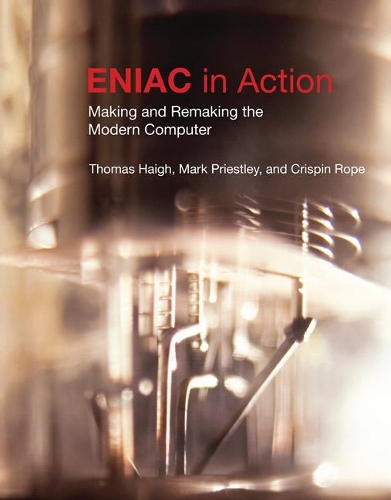
ENIAC in Action: Making and Remaking the Modern Computer
(Paperback)
Publishing Details
ENIAC in Action: Making and Remaking the Modern Computer
By (Author) Thomas Haigh
By (author) Mark Priestley
By (author) Crispin Rope
MIT Press Ltd
MIT Press
26th January 2018
United States
Classifications
Professional and Scholarly
Non Fiction
Personal computers
004.09
Physical Properties
Paperback
366
Width 178mm, Height 229mm, Spine 16mm
Description
The history of the first programmable electronic computer, from its conception, construction, and use to its afterlife as a part of computing folklore.Conceived in 1943, completed in 1945, and decommissioned in 1955, ENIAC (the Electronic Numerical Integrator and Computer) was the first general-purpose programmable electronic computer. But ENIAC was more than just a milestone on the road to the modern computer. During its decade of operational life, ENIAC calculated sines and cosines and tested for statistical outliers, plotted the trajectories of bombs and shells, and ran the first numerical weather simulations. ENIAC in Action tells the whole story for the first time, from ENIAC's design, construction, testing, and use to its afterlife as part of computing folklore. It highlights the complex relationship of ENIAC and its designers to the revolutionary approaches to computer architecture and coding first documented by John von Neumann in 1945. Within this broad sweep, the authors emphasize the crucial but previously neglected years of 1947 to 1948, when ENIAC was reconfigured to run what the authors claim was the first modern computer program to be executed- a simulation of atomic fission for Los Alamos researchers. The authors view ENIAC from diverse perspectives-as a machine of war, as the "first computer," as a material artifact constantly remade by its users, and as a subject of (contradictory) historical narratives. They integrate the history of the machine and its applications, describing the mathematicians, scientists, and engineers who proposed and designed ENIAC as well as the men-and particularly the women who-built, programmed, and operated it.
Reviews
Bad history makes false claims about firsts. Good history makes true claims about firsts. Great history, however, doesn't primarily concern itself with firsts at all (though it may necessarily deal with them as part of the subject matter), but redirects us to ask deeper, more meaningful questions. Great history, like the work of Tom Haigh, Mark Priestley, and Crispin Rope, goes beyond the baseline of facts, the high-school textbook version, into a whole new realm of interpretation.
* Computer History Museum *...a particularly important, thorough, and balanced account, a major contribution to the history of early computing, and certainly required reading for any student of the subject.
* SIAM News *[A] nuanced, engaging and thoroughly researched account of the early days of computers, the people who built and operated them, and their old and new applications.... [T]he creativity and intelligence of good historians writing books such as ENIAC in Action will keep us informed and entertained.
* Forbes *Author Bio
Thomas Haigh is Associate Professor of Information Studies at the University of Wisconsin-Milwaukee. Mark Priestley is an independent researcher. Crispin Rope is an independent researcher.
